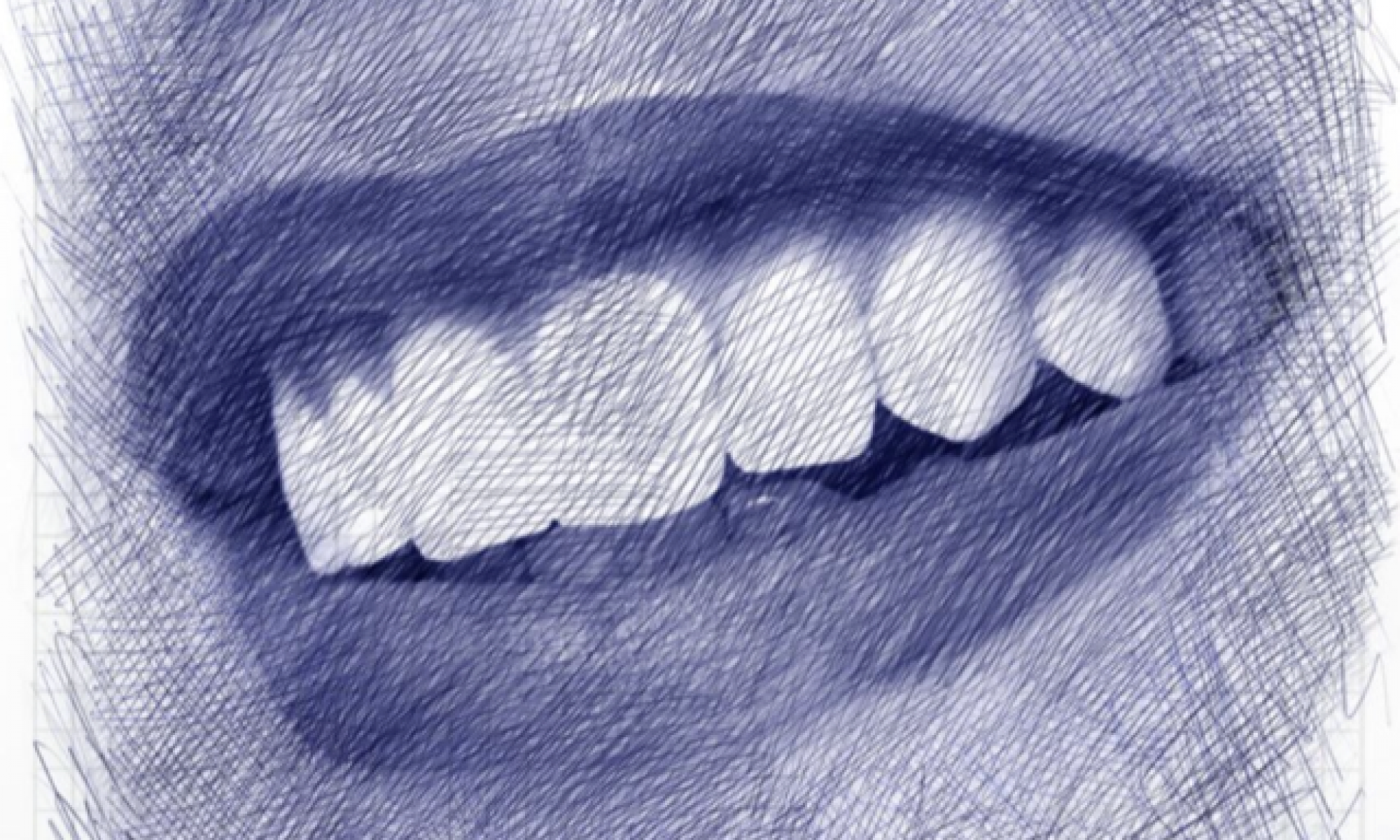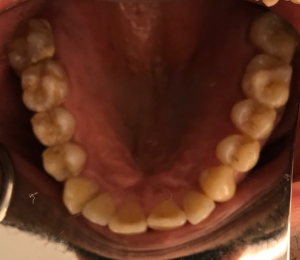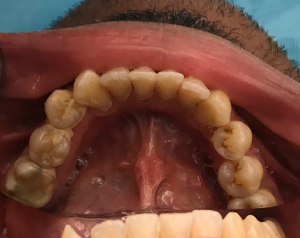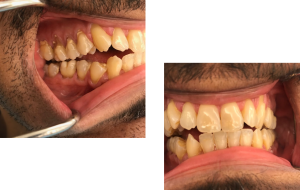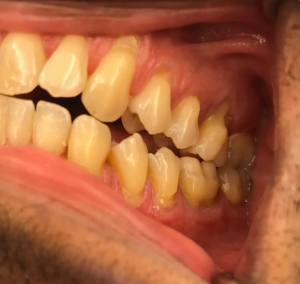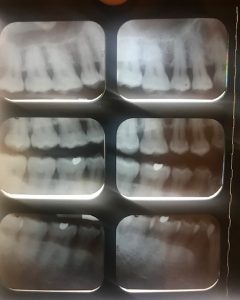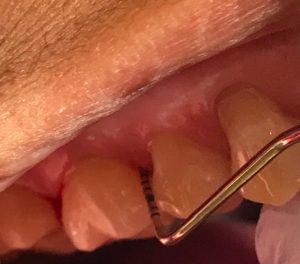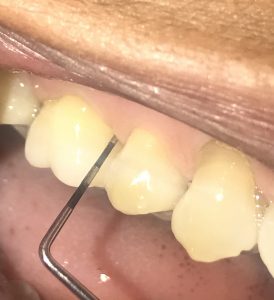Case 1:
Case #1 is a 59-year-old African American, male. He is an ASA II patient, that lives in Brooklyn, NY with is his wife, two children, and dog. He is an alumnus of NYCCT and has a bachelors degree in radiology technology. He currently works as a supervisor of a radiology department at Brooklyn Hospital and he is currently insured with a dental plan. Finding time to visit the dentist accessing dental treatment has been an issue, as life has been extremely hectic and busy for this gentlemen.
His last reported dental visit was in 2008, where he reported having had a filling place, a hygiene cleaning and 4 horizontal bitewings taken.
Oral self-care consists of brushing one time a day in the morning, along with a general OTC toothpaste. He reports using Listerine Antisceptic mouth rinse after his morning brush. No reports of an interdental cleaning aid or a specialized tongue cleaner at the initial visit.
When reviewing medical history patient reports being diagnosed with hypertension about 5 years ago and takes Amlodipine 10mg daily, in the morning for management. Known side effects of taking calcium channel blockers such as Amlodipine 10mg is lightheadedness, drowsiness, swelling of ankles tenderness or bleeding of the gums, xerostomia and gingival hyperplasia.
Periodontal Diagnosis:
Patient in case study #1 presented as a Heavy case, with type II localized type III active periodontitis, without radiographic evidence of bone loss. This patient presented with;
- Generalized heavy BOP.
- Generalized 4-5mm pocketing, with localized 6-7mm pocket depths.
- Generalized moderate recession on all posterior teeth ins sectant 1,3,4 and 6.
- Class I mobility on #23, #24 and #25.
Last radiographs were taken in 2008, outside of New York City College of Technology’s dental hygiene clinic. Patient-reported an FMS was taken at his last dental visit in 2008.
We were unable to retrieve those images since the radiographs were greater than 3 years old.
Intraoral Photos:
Patient care plan and strategies
Educated and implemented quadrant therapy, due to possible gingival tenderness, heavy calculus and pocket depths.
Visit 1, consisted of scaling on the UR and LR quadrants. Educated patient on the period process. Instructed proper oral hygiene care by teaching correct floss and brush technique. The patient also left with a referral to see a general dentist for a comprehensive examination and check up. He was also referred to visit a periodontist for an evaluation. Documentation of dental facilities was given to the patient for both general dental and periodontal needs.
Visit 2, consisted of scaling on the UL and LL quadrants. Encouraged patient to begin using and an electric toothbrush to help reduce abrasive brushing and better disruption of biofilm.
This patient was polished with fine prophy paste and given 5% NaF varnish for anticavity purposes. I recommended patient to brush 2 times a day, morning and night, floss nightly and to continue using an antiseptic rinse one time a day. This patient was encouraged to return for a recare appointment in 3 months to help aid maintain periodontal health.
3 Month Recare visit:
The patient returned after 3 months for routine hygiene maintenance. Medical history remained the same, and he continued to take 10mg of Amlodipine one time a day in the morning. His current Oral self-care was brushing 2 times a day, and he was now flossing 4 times a week.
After an evaluation of his gingiva, the patient now presents with increased pink gingiva and stippling on the anterior quadrant of the maxilla and the mandible. There was minimal inflammation and bleeding on probing at this time.
At the end of my patient’s treatment, I was extremely satisfied with the results. My patient went from heavy visible calculus on all surfaces of the posterior teeth, to having none. It was an extremely rewarding feeling when he left my chair looking and feeling like he had a healthier mouth.
Case #2
Case #2 is a 60-year-old African American, female. She is a retired ASA II patient, that lives in Brooklyn, NY. She is not under any dental insured plan and has not visited the dentist since 2010 due to budget.
Oral self-care consists of brushing one time a day in the morning, along with a general OTC toothpaste. She does not use a Listerine antisceptic mouth rinse, no interdental cleaning aid or a specialized tongue cleaner at the initial visit.
An FMS was taken at NYCCT in April 2018.
When reviewing medical history patient reports being diagnosed with hypertension and takes Diovan 320mg daily, in the afternoon for management. Known side effects of taking Angiotension II like Diovan 320 mg is Fatigue, nausea, swelling, vision problems, chest pain and xerostomia.
Periodontal Diagnosis:
Patient in case study #2 presented as a medium case, type II active periodontitis, with radiographic evidence of bone loss.
- Generalized moderate BOP.
- Generalized 4-6mm pocketing.
- Localized 2mm recession present on #13B, #14B, #24L, #25L
FMS Radiographs
Prob Depths
Above are photos of 6mm pocket depths present on tooth #3.
Patient care plan and strategies
I educated the importance of quadrant therapy. We discussed the options of reducing perio depths by placing the antibiotic minocycline (Arestin) to the 5mm and above pockets.
The treatment plan was signed and consented by the patient.
Visit 1 consisted of scaling on the UR and LR quadrants. I educated the patient on the perio process. Instructed proper oral hygiene care by teaching correct floss technique.
Visit 2 consisted of scaling on the UL and LL quadrants. Placement of arestin in several areas was initiated in pockets containing 5mm and above ( included #3 DB and #3MB.)
Delivered verbal and written post-arestin instruction.
- NO eating or drinking for 30 min after placement
- Avoid touching area
- Wait 12 hours after treatment before brushing teeth
- Avoid flossing for 10 days in area’s that arestin was placed.
This patient was polished with fine prophy paste and given 5% NaF varnish for anticavity purposes. I recommended the patient to brush 2 times a day, morning and night, floss nightly and to begin using an antiseptic rinse one time a day. This patient was encouraged to return for a perio evaluation after arestin placement in 4 weeks. Recare appointment was encouraged for 3 months to help aid maintain periodontal health.
4 Week Evaluation
When this Case #2 Patient arrived for a 4-week re-evaluation, some area’s improved tremendously, while others remained the same.
After an evaluation of her gingiva, the patient now presents with a decrease in inflammation in areas where pockets were between 5-6mm. Above are photos of #3DB and #3MB. Pocket depths in those area’s decreased to 3mm when the pocket reading was originally at 6mm.
Current oral self-care consists of flossing at a minimum of 3 times a week, brushing 2 times a day and she has begun using an antiseptic mouth rinse.
At the end of my patient’s treatment, I was satisfied with the results. I believe that my goal for this patient was partially met as some areas did remain the same. She has increased her oral self-care and has begun implementing many of the recommendations had given to her. Although it is a slow process, she has made progress and I am ultimately satisfied. I did continue to encourage nightly flossing and to continue having her 3-month hygiene maintenance appointment.
